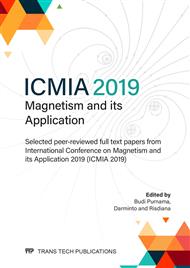[1]
T. Mori, Electronic properties of organic conductor,, Springer, Japan, 2016, Chapter 6, Superconductivity. ISBN 978-4-431-55263-5.
Google Scholar
[2]
K. Kanoda et al., Upper critical field and NMR relaxation studies of an organic superconductor, k-(MDT-TTF)2AuI2,, Synth. Met., vol. 56, no. 2–3, p.2871–2876, (1993).
DOI: 10.1016/0379-6779(93)90049-3
Google Scholar
[3]
A. M. Kini et al., (MDT-TTF)2AuI2: An ambient pressure organic superconductor (Tc = 4.5 K) based on an unsymmetrical electron donor,, Solid State Commun., vol. 69, no. 5, p.503–507, (1989).
DOI: 10.1016/0038-1098(89)90229-9
Google Scholar
[4]
Y. Nakazawa and S. Yamashita, Thermodynamic properties of κ-(BEDT-TTF)2X salts: Electron correlations and superconductivity, Crystals, 2, 741-761 (2012).
DOI: 10.3390/cryst2030741
Google Scholar
[5]
Y. Nakazawa, S. Imajo, Y. Matsumura, S. Yamashita, and H. Akutsu, Thermodynamic picture of dimer-Mott organic superconductors revealed by heat capacity measurements with external and chemical pressure control, Crystals, 8, 143 (2018).
DOI: 10.3390/cryst8040143
Google Scholar
[6]
Y. Kobayashi, T. Nakamura, T. Takahashi, K. Kanoda, B. Hilti, and J. S. Zambounis, Observation of the coherence peak of 1H-NMR relaxation rate in the superconducting state of (MDT-TTF)2AuI2,, Synth. Met., vol. 70, no. 1–3, p.871–872, (1995).
DOI: 10.1016/0379-6779(94)02684-q
Google Scholar
[7]
Y. Tsubokura et al., Gap symmetry of organic superconductor κ-(MDT-TTF)2AuI2 determined by specific heat,, Synth. Met., vol. 85, p.1515–1516, (1997).
DOI: 10.1016/s0379-6779(97)80328-1
Google Scholar
[8]
K. Ichimura et al., STM Spectroscopy on Anisotropic Superconductors,, J. Supercond., vol. 12, no. 3, p.519–523, (1999).
Google Scholar
[9]
K. Kanoda, Mott-Insulator Transition in k-ET2X and (DCNQI)2M,, J. Phys. Soc. Jpn., 75, 051007, (2006).
Google Scholar
[10]
Y. J. Uemura, Muon spin relaxation studies on high-TC, organic, heavy-fermion, and Chevrel phase superconductors,, Physica B, 169, 99 – 106, (1991).
DOI: 10.1016/0921-4526(91)90214-y
Google Scholar
[11]
D. Craik, Magnetism Principles and Applications,, Wiley, Chichester, 1995, p.93.
Google Scholar
[12]
A. Hountas, A. Terzis, G. C. Papavassiliou, B. Hilti, M. Burkle, C. W. Meyer, J. Zambounis, Acta Crystallographica Section C: Crystal Structure Comm., 46, 228 (1990).
DOI: 10.1107/s0108270189006220
Google Scholar


